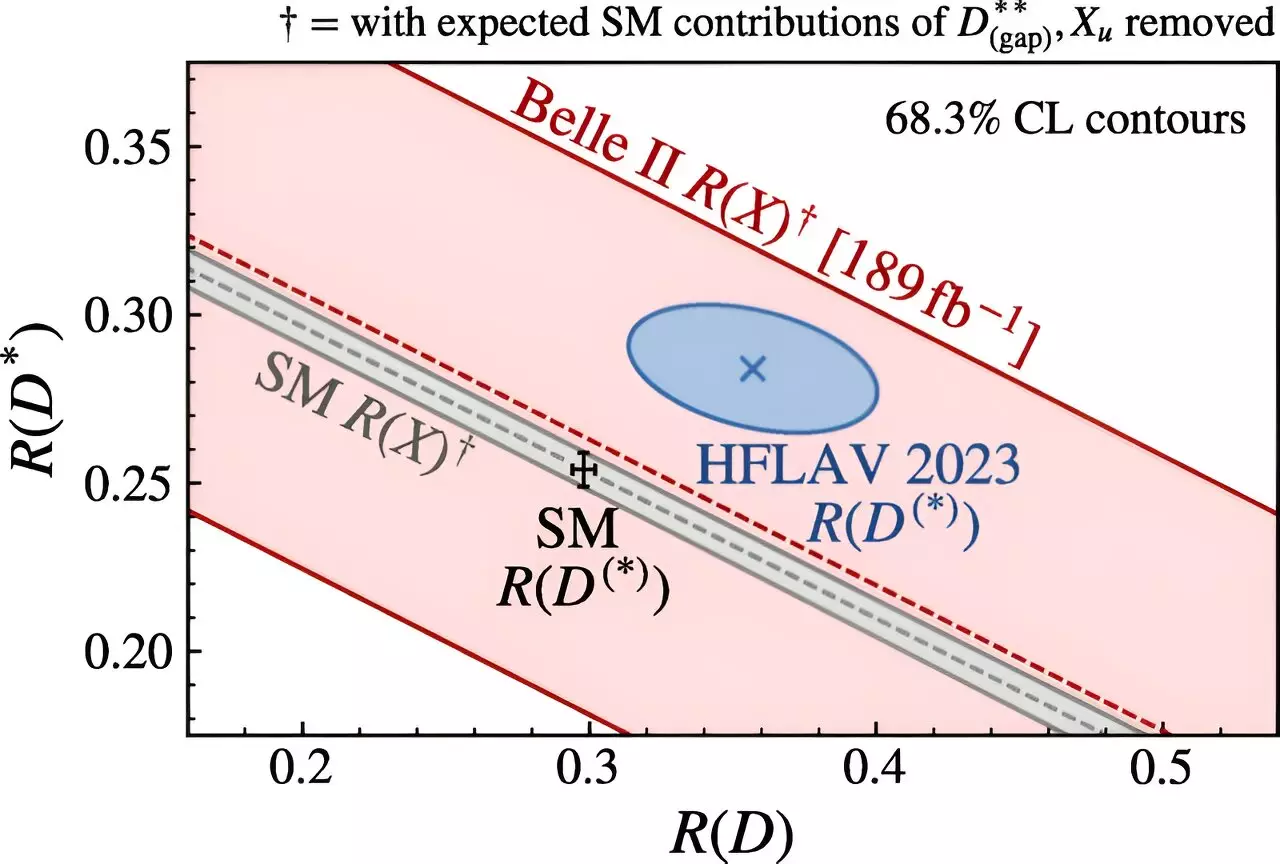The Belle II experiment represents a monumental leap in the realm of particle physics, primarily driven by the ambition to finesse the measurements of weak-interaction parameters and explore the enigmatic category of exotic hadrons—subatomic particles that elude conventional understanding. Conducted at Japan’s High Energy Accelerator Research Organization (KEK) in Tsukuba, the experiment operates alongside the SuperKEKB particle collider, generating a wealth of data analyzed by the Belle II detector. It is within this sophisticated setup that researchers aim to make groundbreaking discoveries that could redefine our grasp of the universe’s building blocks.
In a groundbreaking paper recently published in *Physical Review Letters*, the Belle II Collaboration unveiled its inaugural direct measurement of the tau-to-light-lepton ratio ( R( tau / ell) ) across inclusive B-meson branching fractions. This measurement serves as a critical test of the universality of charged-current weak interactions, a principle posited by the standard model of particle physics. As Karim Trabelsi, the spokesperson for the collaboration, articulated, this research aims to illuminate whether charged leptons—namely the electron, muon, and tau—exhibit identical interactions with weak and electromagnetic forces.
Lepton Universality: A Fundamental Principle Under Scrutiny
Lepton universality stands as a cornerstone principle of our current understanding of particle physics. If particles behave distinctly when interacting through weak forces, it suggests an underlying physics beyond the established norms. The Belle II Collaboration’s latest findings generate excitement not merely because they provide data congruent with the standard model but because they harbor the potential of revealing cracks in this theoretical foundation.
Trabelsi emphasized the focus on comparing tau leptons with their lighter counterparts, electrons, and muons, due to a noted discrepancy between existing measurements and theoretical predictions of lepton universality. The investigative switch from exclusive decays, which focus on single charmed mesons, to inclusive decays serves not only to expand the scope of their research but also to invoke a comprehensive understanding of lepton behavior, detailing interactions with a variety of accompanied hadrons.
This holistic approach serves a dual purpose: it not only captures more extensive decay scenarios but also lays the groundwork for scrutinizing lepton universality comprehensively. Theoretical predictions regarding exclusive and inclusive decays differ considerably, and researchers argue that both must be seen as complementary for an accurate portrayal of charged lepton behavior. The unfolding dynamic of this research delivers a refreshing angle on the lepton universality conversation.
A Methodological Innovation: The Belle II Analysis
What sets this study apart is its methodological innovation. The Belle II Collaboration utilized an unprecedented direct measurement, the first of its kind in over two decades, by leveraging data gathered from the Belle II detector. They specifically focused on the production of B meson pairs devoid of other accompanying particles, a stark contrast to the methodologies invoked by previous experiments like LEP.
The analytical methods employed—the reconstruction of one B meson and tracking down the resultant lepton from decays—are sophisticated and meticulously calibrated. The distinction between prompt lepton emissions from B mesons and those resulting from tau decays makes for an intricate analysis that demands attention to detail, as variations in lepton momentum and accompanying neutrinos pose challenges that require advanced statistical techniques and stringent background calibrations.
While the Belle II team acknowledges that systematic uncertainties may shadow their measurements, they remain confident that ongoing data collection and analysis will illuminate clearer pathways forward. The collaboration primes itself for the eventuality of accumulating more data, which could validate or refute current hypotheses regarding lepton universality.
The Road Ahead: A Pathway to New Physics
The implications of this pursuit are monumental, heralding a new era of inquiry into the potential for discovering unknown realms of physics. More precise measurements of the tau-to-light-lepton ratio will illuminate the conditions under which lepton universality might bend or break, thereby signaling the presence of non-standard model physics. As Trabelsi aptly noted, the initiative to reconcile these observations with the anomalies uncovered in exclusive decays will spur further investigations into the elusive nature of particles that challenge conventional understanding.
The Belle II Collaboration stands at the cusp of pioneering a fresh trajectory in particle physics, equipped with cutting-edge tools and an unyielding commitment to scientific discovery. With aspirations to refine their inclusive measurement alongside concurrent investigations into exclusive scenarios, the stage is set for a deeper exploration of the fundamental forces that govern our universe. The potential to shift paradigms and disrupt centuries of established scientific tenets is tantalizingly within reach, reflecting the exhilarating frontier of modern physics exploration.


Leave a Reply